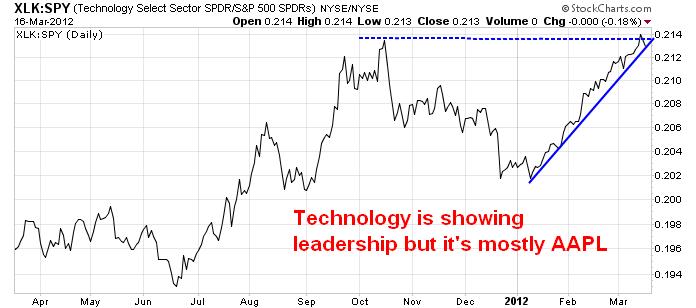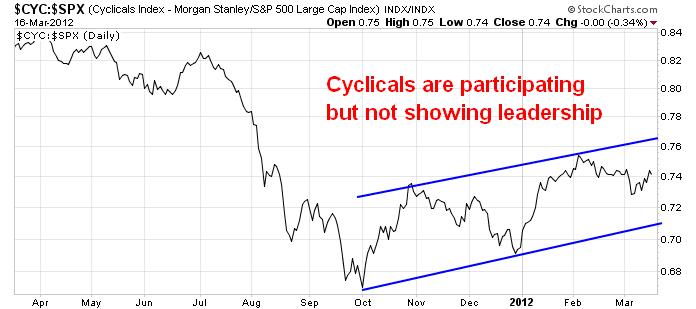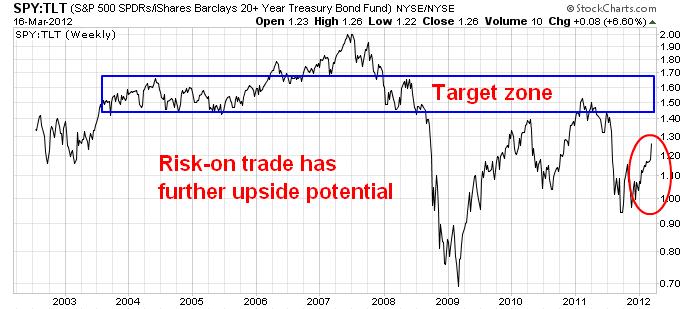I suppose I should be happy. I was correctly bullish on stocks and the Dow has decisively broken through the 13K mark, the NASDAQ Composite is through 3,000 and the SPX has rallied above 1,400. Positive momentum was confirmed by overseas markets such as the European markets, which also staged upside breakouts through technical resistance. It turns out I was right, but for the wrong reasons.
Surprising leadership
What's been surprising to me is the nature of the leadership in this rally. This rally was underpinned by global central bank liquidity. The BoJ, BoE, ECB and the Fed have all undertaken some form of quantitative easing and the flood of liquidity usually buoys asset inflationary expectations, which leads to rallies in commodities, cyclicals and high beta growth groups such as emerging markets. This time, the leadership in equities has not been in those sectors, but something more unusual.
Consider where the leadership has come from in this rally. First of all, the usual defensive sectors such as Utilities and Consumer Staples are lagging (not shown). Next, we see a turnaround in Financials, which is consistent with the narrow miss from a global financial meltdown from the eurozone crisis. The chart below shows the relative performance of Financials against the market. The sector has turned around and staged an upside relative breakout, which is not surprising under the circumstances.
Next, we see surprising leadership from Consumer Discretionary, which is providing leadership as it is in a well-defined relative uptrend against the market.
In another surprise, we see a similar pattern with the Homebuilders.
There is also apparent leadership from Technology stocks, but the relative performance of Technology is mainly from a single stock: Apple (AAPL).
Consider the relative performance of the equal weighted NASDAQ 100, which largely eliminates the price performance of AAPL. Views in this context, the relative performance of the Technology sector has actually stalled and it's been rolling over in the last month or so.
What is surprising is that cyclical stocks are not showing the expected leadership in this rally, though they are participating in the upturn.
Neither are traditional high-beta groups like emerging market stocks.
Commodity prices, as represented by the CRB Index, are turning up - but the bull move has been anemic given the tsunami of central bank liquidity that's hit the markets in the past few months.
The consumer ascendant?
What's going on? What is the market saying?
I believe that the message of the market is, growth depends upon the American consumer. We are seeing an unusual stock market leadership pattern and bond prices tanking (which I discussed in further detail here in my last post). What the market is saying, in effect, is that the US economy is hitting escape velocity and growth, which is based on the US consumer, is starting to look self-sustaining.
Wow! The American Consumer is now the New Growth stock theme! Even The Economist is talking about a recovery - so it must be true.
True, the consumer is eating out more (see analysis here), which is a boost for Consumer Discretionary stocks. Housing seems to be stabilizing and showing uncertain signs of recovery, but there are indications that we are seeing a low quality housing recovery as the consumer seems to be trading down to mobile homes.
I was quite comfortable getting bullish based on a global central bank liquidity theme. As they say, "Don't fight the Fed." I am less comfortable with pinning my bullish outlook on the American consumer and robust US economy growth. With the ECRI sticking with its recession call, which is admittedly a fragile stick-your-neck-out call, this puts the rally on a less firm and riskier ground.
In fact, star bond manager Jeffrey Grundlach said in an interview that he expects bond yields to rise further and it would choke off any economic recovery:
Veteran bond investor Jeffrey Gundlach, who runs $30 billion at DoubleLine Capital in Los Angeles, said yields could rise further but the 10-year yield would have trouble holding much above 3 percent because that level would hurt the economy.
"Now that Treasuries have broken out to higher yields after six months of mind-numbingly low volatility, it is logical to expect the move to higher rates to last more than one week," Gundlach said. "The way things look today I think a move toward 3.25 percent would weaken the economy noticeably."
To be sure, high frequency economic releases have been coming in mainly above expectations, but insiders have been selling heavily, which is bearish. Looking globally, it's not clear that this recovery is self-sustaining at all. To put the burden of the stock market rally on the US economy and consumer is indeed a heavy weight to bear.
The CRIC Cycle: Crisis, Response, Improvement, Complacency
Does this mean that investors should sell all their stocks and run for the hills? Not yet. Barry Ritholz wrote about what he termed the CRIC Cycle.
- Response: When any crisis reaches a panic stage, authorities will typically react (and overreact) creating an overwhelming response to the crisis. This usually includes lots of cash and some immediate legislative relief.
- Improvement: This response throw enough money at the problem that symptoms are temporarily relieved. The improvement is not structural, but rather, is driven by a sugar rush of excess liquidity. It feels good but it is not economically nutritious.
- Complacency: The baling wire, chewing gum and duct tape improvements of the temporary patchwork repair creates a false sense of accomplishment. The improvements feel good, the data improves, markets rally. This leads to a sense of complacency amongst all parties (Government, private sector, banks, consumers, etc.)
- Repeat: With few of the structural problems fixed, the excess liquidity eventually flows to the same sources of the original crisis, setting the stage for the next crisis.
He went on to say that he believed the US is in the late stages of this cycle:
Bringing us up to date, the US appears to be deep in the Complacency stage. Things have noticeably improved, but the structural problems underneath remain.
In Europe, we seem to be late in the Response phase, awaiting the early Improvement part of the cycle to kick in.
I agree with his assessment. The chart below of a ten year history of the ratio of SPY (stocks) to TLT (long Treasury bonds) as a measure of the risk-on/risk-off tells me that this risk-on rally has further upside potential as risk appetites are only normalizing.
The Ritholz wild-eyed guess scenario, which he wrote on February 21, 2012 before the brief market downdraft, is sounding more and more plausible:
If the past is prologue (and that cannot be relied upon), we could see a scenario something like this (Note: Wild ass guessing to follow). Markets kiss 13,000, pullback and consolidate. But they are not overbought sufficiently for anything more serious than a modest retracement, and so they continue higher for several months, until the % of stocks over 200 day MA is near 90% (they are at 75% today). That takes us somewhere between March and June. The next sell off begins, lopping 25% or so off of the SPX. The Federal Reserve waits until after the November election to introduce QE3, and the cycle starts anew.
My inner investor remains bullish, but he is a nervous bull. My inner trader tells me not to worry. These issues with the American economy and consumer are 3Q or 4Q problems. So let's party on, but keep an eye out for the exit.
